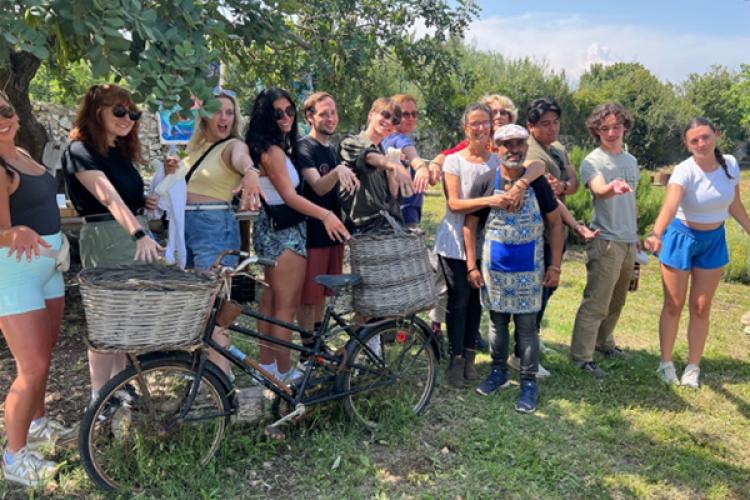
Food in Sicily students see how emigration changed Sicily as integration threatens its identity

In the park of the Villa Communale in the ancient hill town of Palazzolo Acreide in the Hyblaean Mountains just 20 miles east of Siracusa, Italy, there is a statue in commemoration of the many local people who emigrated and the effect that migration has had on subsequent generations.
On one side of the statute, visitors see the immigrant’s arm and leg dressed in threadbare clothes and rough working boots, carrying a beat-up suitcase held together by rope. On the statue’s other side, the arm and leg are now dressed in smart city clothes with polished leather shoes and a modern new briefcase.
The poignancy of the transformation from impoverished traveler to a man of success is immediately felt when viewing this artwork—in fact, as one recent visitor, Ohio University nursing student Liz Meserini recorded in her reflection journal for the Food in Sicily program, “I felt connected to this statue because my Great Grandpa moved to America from Sicily with almost nothing, and now I have this amazing life.”

Part of Meserini’s amazing life this summer included joining other OHIO students on the May study away program, Food in Sicily. In addition to Palazzolo Acreide’s beautiful town park, the students' in-depth experience of Sicilian food and culture took them to Claudio Romano’s Agriteatro Sensoriale: an immersive farm experience in the sounds, smells, tastes, and tactile elements of this part of Sicily.
Romano is one of the many Sicilians who left the island, migrating north for employment. But, unlike others, he returned to the Iblei Mountains with his partner, Rossella Di Brigida, not to display newly found immigrant wealth but to reclaim the richness of his cultural roots by designing the Agriteatro Sensoriale at their family farm, Casa Contadina Iblea.
The Hyblaean Mountains, or Monti Iblei in Italian and Munt'Ibblei in Sicilian, run between Siracusa and Ragusa in the southeastern corner of Sicily and are made up of low mountains with steep canyons and valleys giving way to rolling limestone hills, with carob and almond groves and vineyards separated by low dry-stone walls. First settled by the Siculi, one of Sicily’s three ancient tribes, who arrived circa 1200 BCE and then four centuries later by the Greeks as an integral part of Magna Graecia, followed by the Romans, the Hyblaean Mountains are dotted with ancient archaeological sites. The origin of the name is disputed, with one tradition claiming the name is derived from the ancient King Iblone who ceded this part of his kingdom to the Greeks or from the Siculian divine mother goddess, Ibla, who protected fertility and brought abundance to the land and its inhabitants.
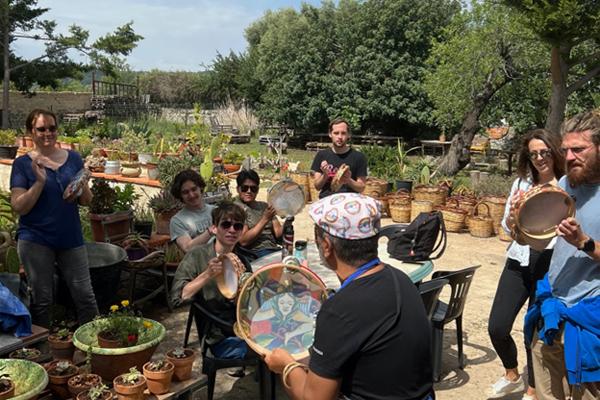
When the Food in Sicily students first arrived at Casa Contadina Iblea, Romano serenaded everyone with Sicilian songs accompanied by his tambourine or tamburello. Then he invited the students to join in, passing out tamburellos and instructing the students in how to strike the drum using the palm, fist, and fingers. Everyone quickly found out that Sicilian tambourine drumming is far more complex than it looks, and as Romano explained, the tamburello is not only an instrument used to accompany song and dance, but also an essential element in Sicilian storytelling, fables, and poetry, for through the goat skins of the drum head not only does the animal still speak, but everyone who is gathered also hears the voice of the Great Mother, Ibla herself.
Following the primordial sounds of the tamburello, the students explored the herb garden and plant nurseries where Romano grows medicinal and culinary herbs and plants – crocus for saffron, lemon balm, sage, thyme, mint, rosemary, and many more. He began collecting wild herbs more than 20 years ago, first as just a pastime. His neighbors nicknamed him arreniaturi or arrichinista, referring to him as “the one who forages wild oregano.”
“Everyone took me for a fool,” he recalled. “Everyone said I was the village idiot.” But Romano knew that the herbs he collected were essential in traditional remedies and folk medicine. As he led the group through his extensive garden, he encouraged everyone to run their hands across the plants, to feel the textures of the leaves and stems, and to breathe in deeply the aroma of each plant. The smells and textures of the plants are key components of his Agriteatro Sensoriale.
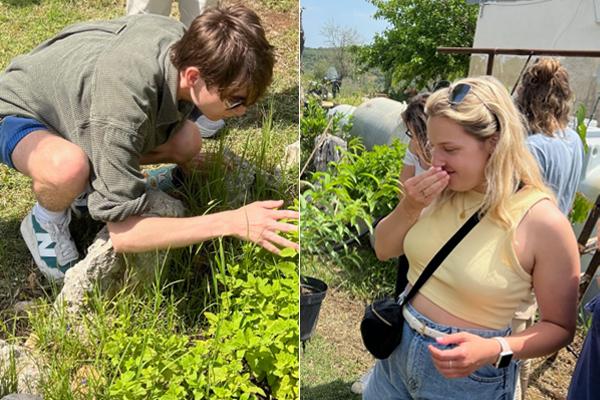
Every experience on the farm is part of the Agriteatro Sensoriale, and Romano and Di Brigida have also created a small theater in the round, with straw, wood and stone seating. Here, Romano recites for his audiences Sicilian dialect poetry, ancient folk tales, and nursery rhymes, all part of the island’s storytelling traditions designed to help pass the time while weaving baskets for the farm. The Sicilian language has been shaped by many years of conquest, occupation, and foreign influence.
Unlike Italian, which is almost entirely Latin-based, Sicilian contains elements of Greek, Arabic, French, Catalan, and Spanish and differs grammatically from Italian. Since 1860, when Sicily became a part of a newly unified country of Italy, there has been the feeling that the Sicilian language is not sustainable and will eventually die out due to the influx and influence of Italian. For Romano, his poetry and storytelling are an act of protecting an endangered language and culture: “The nursery rhymes I tell mention all the things that have been lost. The words represent our identity, our land.”
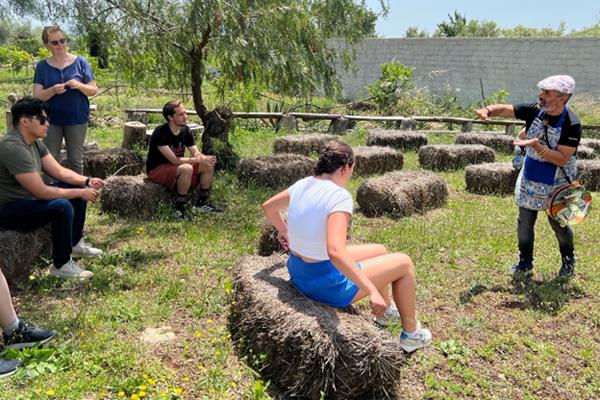
Sicilian identity and the bounty of the land filled the luncheon table as well. Students enjoyed homemade savory tarts and fresh cheeses along with bitter greens and tomatoes dressed with the farm’s own olive oil and vinegar. It was a spectacular way of tasting the cultural foodways of the island.
“That was hands down my favorite lunch,” Gabrielle (Gabi) Dozer, a nursing student and sergeant in the Air National Guard, said. “It was the most authentic, delicious meal I have ever had. Eating and drinking all that food from the farm was just what I needed!”
Russ College of Engineering and Technology Cutler Scholar Orlando Gonzalez noted that the attention and skill that Romano and Di Brigida put into making the meal, “the way they prepared the food for us was magnificent, the flavors were so carefully prepared and generously shared, in a way that they appeared to not only be mere food but were bridges that connected the family that prepared them, their work, their knowledge and their values.”
Romano and Di Brigida are also master weavers, working with olive, willow, cane, broom, myrtle and carob, which they forage themselves, to fashion containers called “panaru” in Sicilian for carrying food such as lemons, grapes, olives, and bread. The baskets are also used for storing and aging food such as ricotta, ricotta salata, and other cheeses, and even for leavening bread so that the loaf takes on the shape and latticework of the basket, and also the flavor of the cane. Panaru may often still be seen tied to a rope, being lowered from balconies to the street below in cities throughout Sicily.
Basket weaving is an ancient tradition, going back centuries in Sicily to the time when baskets were made inside the family circle, during wintertime, as bad weather made fieldwork impossible. “I enjoy weaving,” Romano told us, “It is a passion, but it’s an identity we inherited from our ancestors.” What’s more, Romano explains that like humans, no two baskets are the same. “Each basket has a soul because the wood is alive. The materials and I must find a way to be one. You hurt your hands, you cut yourself, but the creation is always different.” (Watch Romano and Di Brigida making panaru and talking about the art of Sicilian basket weaving.)
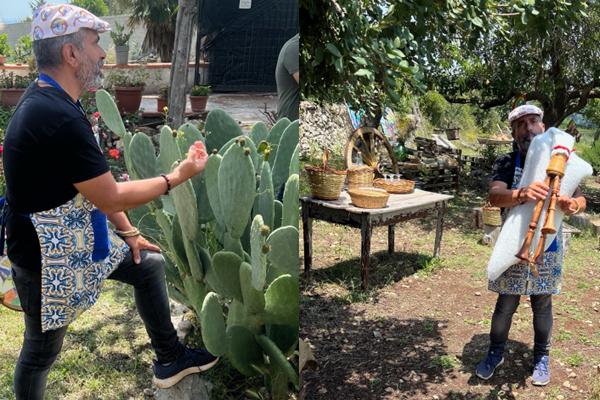
Di Brigida helped students select suitable branches and with their help wove everyone a made-to-measure bracelet, "u vrazzalettu,” or ring, "l'aneddu.” Romano accompanied the weaving with some music, but this time he brought out his zampogna or ciaramèddha in Sicilian. The ciaramèddha is a type of zampogna or Italian bagpipe found throughout Italy, but especially popular in Sicilian folk music, and specifically in mountainous regions where sheep and goat herding are prevalent. The air bag of the zampogna is made from the complete hide of a sheep or goat. At slaughter, the hide is carefully removed in one piece, dried and treated (like drum skins are), and turned inside out so that the full coat of the animal is left intact inside the bag. One front leg and both rear legs are tied to contain the air while the remaining front leg is used as the air canal through which the player’s breath travels to fill the air bag and then release it upon playing. The ciaramèddha is one of the principal instruments along with the tamburello used in communal dances like the tarantella. For more about the zampogna and to hear what it sounds like, check out David Marker’s film, “Zampogna: The Soul of Southern Italy.”
The day at the farm concluded with a lesson in traditional cold process soapmaking. Di Brigida uses the olive oil left over from last year’s harvest and mixes it with caustic soda and water. Herbs and essential oils from the farm’s extensive gardens are then added to perfume the final product. She sells her soap at nearby markets with rose, calendula, lavender, and rosemary being her most frequently requested scents. It is hard not to take soap for granted, but as Russ College of Engineering and Technlogy Cutler Scholar Gavin Morgan observed, “Learning the chemistry behind the soap making led me to find out that it’s a bit more difficult to perfect than I thought!”
With the day drawing to a close, the students thanked their hosts who encouraged them to gather fragrant bunches of herbs to refresh and center them for the bus trip back to the city.
While the day at Agriteatro Sensoriale concluded the three weeks of Food in Sicily’s experiential learning, the students carried home with them the flavors of Sicily and the knowledge that as Morgan said, “The memories made and relationships strengthened just over a table of food proves the power that food holds.”
About the Food in Sicily program, May 8 - 28, 2024
Please contact David Bell, director, Food in Sicily Study Away program at belld@ohio.edu for more information or visit the Food in Sicily homepage. Join an info session via Teams.
Info Sessions via Teams
Wednesday, Sept. 20, at 7:30 p.m.
Wednesday, Oct. 18, at 7:30 p.m.
Wednesday, Nov. 15, at 7:30 p.m.
Wednesday, Dec. 13, at 7:30 p.m.
